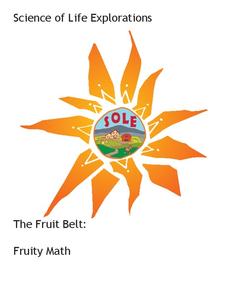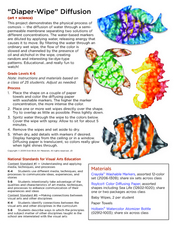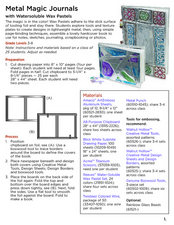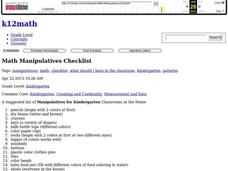Urbana School District
Light
You matter, unless you multiply yourself by the speed of light ... then you energy. Presentation covers the behavior of light as both a wave and a particle, light versus sound, space travel, why objects have colors, depth perception,...
Normal Community High School
Chemical Equations
Viewers learn how to identify the substances in a chemical reaction, how to balance it, and the different types of chemical reactions by watching a presentation that also includes a review of monomers and polymers. The presentation ends...
Cornell University
Fruity Math
Nothing sounds more delicious than fruity math! Young mathematicians solve fraction and multiplication word problems about berries, grapes, and more.
American Museum of Natural History
What's the Big Deal About Paleontology?
Paleontologists could be considered detectives of the past. A quick online lesson describes the science of paleontology and the importance of fossils. Young scientists read about how paleontologists analyze the features of fossils to...
Curated OER
Seashell Painting
Let nature inspire your budding artists. They paint seascapes on actual seashells. First, they observe the seaside, then they paint what they see (image or in person) on the inside of a white shell.
Curated OER
Underwater Sea Garden: Washes
After modeling by the instructor, young artists practice wash, wet-on-wet, wet-on-dry, and dry-on-dry painting techniques.
American Chemical Society
Colors Collide or Combine?
As part of a unit investigating the dissolving of M&Ms® candy coating, this lesson examines whether or not the different colors combine. There are no new concepts revealed in this particular lesson, but learners will see that the...
Curated OER
Diaper-Wipe Diffusion
Explore osmosis through art. Learners use paper towels and markers to create beautiful designs. Although a simple activity, the results are quite remarkable. Your class will love this lesson!
Curated OER
Octopus Project: Ceramics
Kids make an octopus out of clay. They practice their sculpting and modeling skills such as pinch pot and slurry technique while sculpting an octopus.
Curated OER
Animals A to Z: Flamingo
In this editing sentences worksheet, students read and edit six sentences about flamingos to find ten errors in capitalization, punctuation, spelling and/or grammar. Students correct each error.
Curated OER
Mixed Media Ocean Art
Students design pictures of ocean environments. In this art lesson, students use mixed media art materials to develop a picture that depicts the ocean environment. They use paint, sand paper and various basic art materials.
Curated OER
Northwest Native American Art
Eighth graders first study the art of the U.S. Northwestern Coast Native American peoples. They select an image or make their own and make a drawing and then make a 6-inch linoleum block print.
Curated OER
Exploring Caves
Students explore the various characteristics of caves. Through class discussion and hands on activities, students identify what forces converge in the creation of a cave. They complete review activities at the conclusion of the lesson...
Curated OER
Crystal Growing
Students grow crystals and document their observations by recording timeing and growth. Additional characteristics of crystals are observed under a black light, by growing under different conditions and mineral content is determined.
Curated OER
Rock of Ages
Young scholars are given a classification table and samples from their location. They locate their samples on the classification table using the characteristics used in rock identification.
Curated OER
Crayon Crackle Painting
Explore crackle painting and Raku pottery with your little learners. They view examples of Raku pottery, discuss the crackle painting technique, and create an original image using crayons and glue. Sounds like an educationally fun time!
Curated OER
Flipping Butterflies: Triadic Colors and Symmetry
Second graders create symmetrical butterfly wings. For this symmetry lesson, 2nd graders observe butterfly wings and create their own. They make both sides symmetrical and mix primary colors to make secondary colors.
Curated OER
Metal Magic Journals
Create beautiful Metal Magic Journals with this lesson plan. They are great for keepsakes and gifts! It is also a fun way to learn about wax and metal.
Curated OER
Patterns
Explore early algebra by participating in a pattern identification activity using a random assortment of different household materials. The class creates, completes, and analyzes different patterns with the help of leggos, buttons,...
Oregon Museum of Science and Industry (OMSI)
DNA Extraction
What does your DNA actually look like? Use simple materials with this experiment to find out! Geneticists of all ages can follow these instructions to extract their own DNA. For learners who are hoping to extend the activity, there are...
Science-Class.net
Rock Candy Crystals
Candy is one of my favorite words, and it's an even better word when it relates to science. Yes, candy science can happen when you grow rock candy crystals with your class. The entire process for growing these edible wonders of nature is...
Curated OER
Know your roots!
Looking at an image of plant systems with their roots in the ground, learners determine which would be the most or least difficult to pull. They write short sentences describing which plant they chose and why. Intended for 3rd or 4th...
Curated OER
Watercolor Collage
Sixth graders study about Impressionism and Post Impressionism. They create a watercolor collage.
Curated OER
Soil Stories
Tenth graders collect and analyze soil samples and extrapolate the characteristics needed to support different types of plant life. They research different types of prairie soil and how it supports plant and animal life.
Other popular searches
- The Color of Water
- Color Schemes in Watercolor
- Temperature Water Food Color
- Heat Water Food Color
- 'The Color of Water
- Food Color and Water Mixed

























